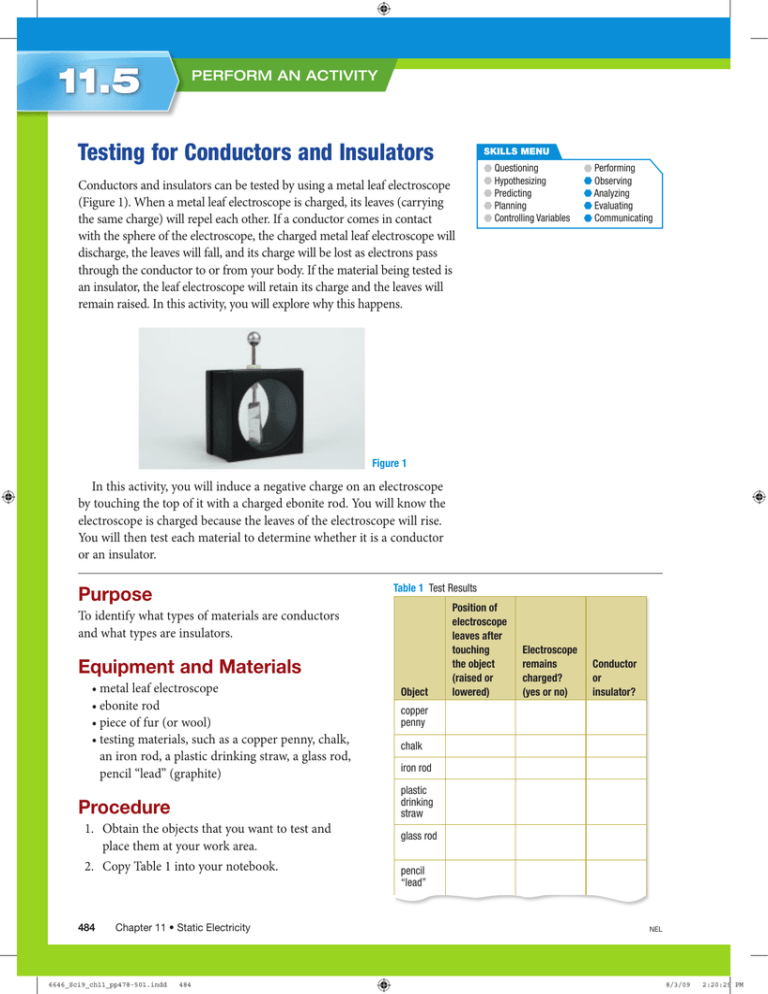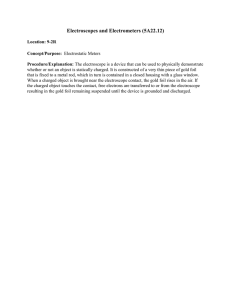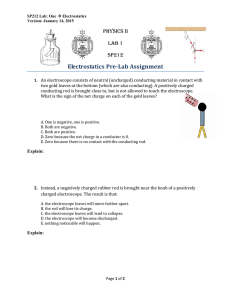Testing for Conductors and Insulators
advertisement

11.5 PERFORM AN ACTIVITY Testing for Conductors and Insulators SKILLS MENU Conductors and insulators can be tested by using a metal leaf electroscope (Figure 1). When a metal leaf electroscope is charged, its leaves (carrying the same charge) will repel each other. If a conductor comes in contact with the sphere of the electroscope, the charged metal leaf electroscope will discharge, the leaves will fall, and its charge will be lost as electrons pass through the conductor to or from your body. If the material being tested is an insulator, the leaf electroscope will retain its charge and the leaves will remain raised. In this activity, you will explore why this happens. Questioning Hypothesizing Predicting Planning Controlling Variables Performing Observing Analyzing Evaluating Communicating Figure 1 In this activity, you will induce a negative charge on an electroscope by touching the top of it with a charged ebonite rod. You will know the electroscope is charged because the leaves of the electroscope will rise. You will then test each material to determine whether it is a conductor or an insulator. Table 1 Test Results Purpose To identify what types of materials are conductors and what types are insulators. Equipment and Materials • metal leaf electroscope • ebonite rod • piece of fur (or wool) • testing materials, such as a copper penny, chalk, an iron rod, a plastic drinking straw, a glass rod, pencil “lead” (graphite) 1. Obtain the objects that you want to test and place them at your work area. 2. Copy Table 1 into your notebook. Chapter 11 • Static Electricity 6646_Sci9_ch11_pp478-501.indd Electroscope remains charged? (yes or no) Conductor or insulator? copper penny chalk iron rod plastic drinking straw Procedure 484 Object Position of electroscope leaves after touching the object (raised or lowered) 484 glass rod pencil “lead” NEL 8/3/09 2:20:29 PM 3. Charge the ebonite rod by rubbing it with a piece of fur (or wool). Touch the ebonite rod to the electroscope terminal in order to charge the electroscope (Figure 2). The leaves should be in the raised position now. If not, repeat the charging process. Do not touch the electroscope terminal with your hands at any point during the testing process. SKILLS HANDBOOK Analyze and Evaluate 3.B.7., 3.B.8. (a) Use your observations to complete the last two columns in your table. T/I (b) Explain how your observations helped you to make your decisions in (a). T/I C (c) Why do you think you were cautioned not to touch the electroscope terminal with your hands during the testing? What do you think would have happened if you did? Discuss your answer with a classmate. T/I C (d) Create a t-chart to sort the materials that were conductors from the materials that were insulators. Do the conductors have something in common? How about the insulators? T/I SKILLS HANDBOOK Apply and Extend 3.B.8. (e) Would the metal leaf electroscope work if the terminal were made from an insulating material? Explain your answer. T/I Figure 2 4. Touch the copper penny to the electroscope terminal. Record your observations in the third column of your table. 5. If the electroscope leaves have returned to the neutral position (hanging down), you must recharge the electroscope as you did in step 3. If the leaves remain raised, the metal leaf electroscope is still charged and you do not need to recharge it. 6. Repeat steps 4 and 5 with the remaining materials and record your observations in your table. C (f) The leaves of the electroscope repelled each other when given a negative charge. Do you think it would be possible to get the leaves of the electroscope to attract each other? Explain. T/I (g) Does this activity have any way of indicating how good an electrical conductor or insulator the material is? If yes, indicate how. If no, what would be required? T/I (h) How might the results of this experiment have been influenced by differences in humidity on the day it was performed? 11.5 Perform an Activity NEL 6646_Sci9_ch11_pp478-501.indd C 485 485 8/3/09 2:20:35 PM

